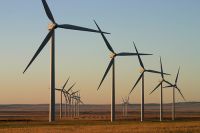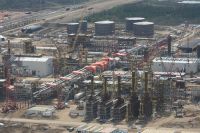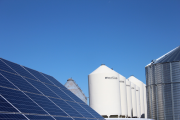A new wind farm approved recently for east-central Alberta will not only be the province's largest, but will also be one of the last to benefit from federal support through the depleted ecoENERGY for Renewable Power program.
The federal funding, which will grant Greengate Power Corp. one cent per kilowatt hour for 10 years of wind farm operation, proved pivotal to bringing the project forward, the Calgary Herald reported this week.
 Despite its success in creating clean energy and new jobs across the country, the federal government's support for renewables through the ecoENERGY program effectively ended when the money quietly ran out last month - more than a year ahead of when it was supposed to, due to its popularity.Taxes generated from wind power projects more than cover the cost of initial government subsidies.
Despite its success in creating clean energy and new jobs across the country, the federal government's support for renewables through the ecoENERGY program effectively ended when the money quietly ran out last month - more than a year ahead of when it was supposed to, due to its popularity.Taxes generated from wind power projects more than cover the cost of initial government subsidies.
This week General Electric released a study indicating that if the ecoENERGY for Renewable Power program was topped up with another $1.5-billion spread out over 14 years, it would prompt the construction of 5.2 gigawatts of new projects (the equivalent output of almost four CANDU nuclear reactors). Interestingly, this 'subsidy' would actually provide the government a net benefit to the tune of $287 million.
Because of the taxes the projects would generate, "essentially the government gets back more than it puts in," said Mark Tonner, managing director for Canada at GE Energy Financial Services. "This is not a cost, this is an investment for the government."
But more importantly, it's an investment in a clean energy future for Canada. Sure, General Electric makes wind turbine equipment (they also make steam turbines used in coal and nuclear plants), but they still make a good point about the logic of investing in renewables - especially when you consider how heavily government has subsidizeddirty sources of energy in the past.
 Opti-Nexen oilsands operation in Long Lake, AlbertaTake the oilsands, for example. Believe it or not, it wasn't long ago that the oil sands weren't profitable, and billions of dollars of government research money were spent on developing technology to bring down costs. Now our governments need to demonstrate the same kind of commitment to the development of renewables.
Opti-Nexen oilsands operation in Long Lake, AlbertaTake the oilsands, for example. Believe it or not, it wasn't long ago that the oil sands weren't profitable, and billions of dollars of government research money were spent on developing technology to bring down costs. Now our governments need to demonstrate the same kind of commitment to the development of renewables.
The ecoENERGY budget was set at $1.48 billion, paid out over 14 years. In comparison, the federal government allocated $1.5 billion in 2009 alone to nuclear power and carbon capture and storage for coal.
Canada has the potential to generate at least 20% of its national electricity from wind alone - a feat Denmark accomplished in 2000. Combined with other renewables, such as biomass, small hydro and geothermal, wind power needs to play a major part in delivering on the government's promise to achieve 90 per cent of Canada's electricity from non-emitting sources by 2020 - but we're not going to get there without smart investments from our governments.










